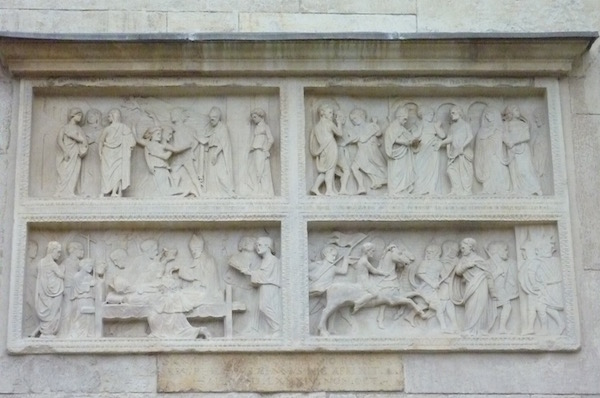We have raced by Modena over these many years countless times on our summer trips to the Alps. Invariably I said, “we must plan a trip someday to visit the Duomo” with Maurizio chiming in…”and to Maranello”. In April, the perfect opportunity presented itself: Modena was a viable midpoint for meeting up with some special Genius Loci guests/friends for a couple days.
the side of the Duomo facing La Piazza Grande.
the beautiful apse of the Romanesque Duomo with the towering “landmark” Ghirlandina Campanile
At the last minute, unfortunately one of our friends fell ill and simply couldn’t come. While we were so sorry she was not well and that we would not have the pleasure of being together, nevertheless,we enjoyed Modena. We soon learned that Modena offers so much more than its remarkable Duomo (although it is far more magnificent than we had even imagined) and its Ferrari heritage and fame.
The Cathedral – il Duomo
Modena Cathedral is a Romanesque church in Modena, Italy. It is the cathedral, or duomo in Italian. Consecrated in 1184, it is one of the most important Romanesque buildings in Europe and a UNESCO World Heritage Site.
Since the 5th century, two churches had existed on the site of the present cathedral: the discovery of the burial site for Saint Geminianus, Modena’s patron saint, led to the destruction of those churches and building of this cathedral by 1099. The initial design and direction was provided by an architect known as Lanfranco. The present cathedral was consecrated on July 12, 1184
After Lanfranco’s stunning work, the Cathedral was decorated by Anselmo da Campione and his heirs, the so-called “Campionesi Masters”. The current façade, therefore, exhibits different styles. The majestic rose-window was added by Anselmo in the 13th century, while the two lions supporting the entrance columns are Roman, probably discovered while digging the foundations.
The façade also has notable reliefs by Wiligelmus, a contemporary of Lanfranco’s; these include portraits of prophets and patriarchs, and most of all the Biblical Stories, a masterpiece of Romanesque sculpture. Art historians point out that along with those of Antelami in Parma, the reliefs of Adam and Eve, depicting the original sin, and the story of Noah are among the finest medieval reliefs of the 1200s in all of Europe.
The side gates are also fascinating – true masterpieces. On Piazza Grande, the Porta Regia (“Royal Gate”), also by the Campionesi Masters, and the shorter Porta dei Principi (“Princes’ Gate”), decorated with a relief depicting episodes of the life of Saint Geminianus, by a pupil of Wiligelmus’.
On the northern side is the highly original Porta della Pescheria (“Fish-Market Gate”), with reliefs inspired by the cycle of the years’ twelve months. Due to the crowds in admiration, it was impossible for us to photograph this amazing “porta”.
The interior is divided into three naves. Between the central nave and the crypt is a sublime marble parapet by Anselmo da Campione portraying the Passion of Christ, including the Last Supper.
The pulpit is by Arrigo da Campione, decorated with small terracotta statues.
above: other various details in the interior
Pavarotti gave many memorable concerts in his hometown Cathedral and his funeral was held in the cathedral.
…and with the Duomo, the delights of Modena have just begun….
stay tuned, please – to be continued….






















